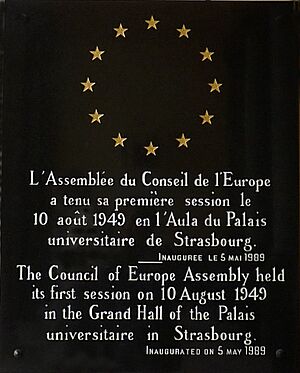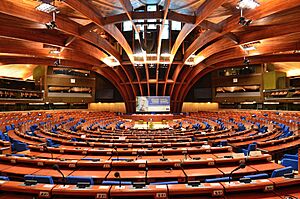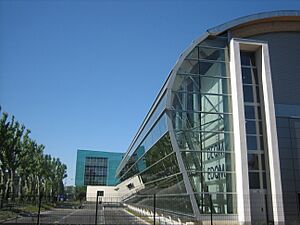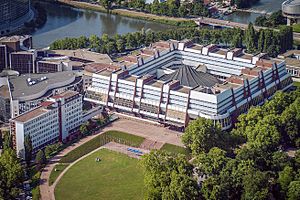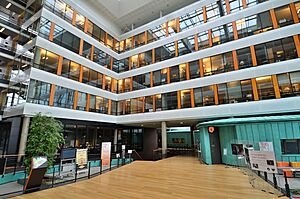Council of Europe facts for kids
Quick facts for kids
Council of Europe
Conseil de l'Europe
|
|
|---|---|
|
|
|
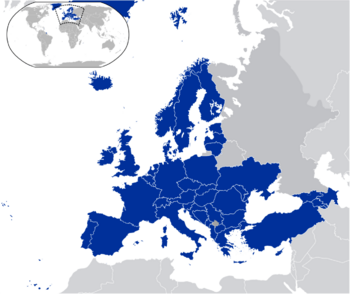 |
|
| Headquarters | Palace of Europe, Strasbourg, France |
| Official languages | English, French |
| Type | Regional intergovernmental organisation |
| Membership |
|
| Leaders | |
|
• Secretary General
|
Alain Berset |
|
• Deputy Secretary General
|
Bjørn Berge |
|
• President of the Parliamentary Assembly
|
Theodoros Roussopoulos |
| Legislature | Parliamentary Assembly |
| Establishment | |
| 5 May 1949 | |
The Council of Europe (often called CoE) is an important international group. It works to protect human rights, support democracy, and make sure everyone follows the rule of law across Europe. It was started in 1949, making it Europe's oldest group of governments working together. Today, 46 countries are members, representing about 675 million people.
It's important not to confuse the Council of Europe with the European Union (EU). They are different organizations. However, the EU uses the same European flag and anthem that were first created for the Council of Europe. Many countries join the Council of Europe before they join the EU.
The Council of Europe creates international agreements, called treaties. One of its most famous achievements is the European Convention on Human Rights. This convention helps protect basic rights for people in member countries. The European Court of Human Rights in Strasbourg, France, makes sure these rights are respected. If someone believes their rights have been violated, they can bring their case to this court.
The Council of Europe has its main offices in Strasbourg, France. It uses English and French as its main languages.

Contents
How the Council of Europe Started
Ideas for a United Europe
Long ago, leaders dreamed of a united Europe. In 1929, French Foreign Minister Aristide Briand suggested a "federal union" to solve common problems. During World War II, in 1943, British Prime Minister Winston Churchill also spoke about creating a "Council of Europe." He wanted to rebuild Europe and keep peace after the war. He repeated this idea in a famous speech in 1946.
Many other leaders and politicians also worked towards this goal. Some saw it as a way to prevent future wars and protect people from unfair treatment. Others hoped it would be a "club of democracies" that shared common values.
The First Steps
In 1948, many politicians and leaders met in The Hague, Netherlands. They discussed how the new European organization should look. They decided to create two main parts:
- The Committee of Ministers: This group would have representatives from each government.
- The Parliamentary Assembly: This group would have members from the national parliaments of each country.
This way, both governments and elected representatives could work together.
Founding Day
The Council of Europe was officially created on May 5, 1949. Ten countries signed the Treaty of London in London: Belgium, Denmark, France, Ireland, Italy, Luxembourg, the Netherlands, Norway, Sweden, and the United Kingdom. This treaty set out the Council's main goals: democracy, human rights, and the rule of law.
Soon after, Turkey and Greece joined. In August 1949, the first meeting of the Parliamentary Assembly took place in Strasbourg. They discussed how to bring Europe back together after the war and protect human rights. This meeting also started the process that eventually led to the creation of the European Union.

Growing Together
One of the Council's first actions was to welcome West Germany in 1951. This helped bring countries together after the war. Over the years, more and more countries joined. Iceland joined in 1950, followed by Austria in 1956, Cyprus in 1961, Switzerland in 1963, and Malta in 1965. Today, there are 46 member states.
What the Council of Europe Does
The main goal of the Council of Europe is to bring its members closer. It wants to protect shared ideals like human rights and democracy. It also aims to help countries make social and economic progress. Any European country that believes in harmony, cooperation, good governance, and human rights can join. They must also promise to protect democracy and basic freedoms.
Unlike the European Union, the Council of Europe cannot make laws that countries must follow directly. Instead, member countries agree to international treaties and work together based on shared values. These treaties help set common standards across Europe.
Protecting Human Rights
The Council of Europe's most famous achievement is the European Convention on Human Rights. This important document was created in 1950. It lists many basic rights that everyone in Europe should have.
The Convention also set up the European Court of Human Rights in Strasbourg. This court makes sure countries follow the Convention. If people believe their fundamental rights have been violated by a member country, they can take their case to this court. The court's decisions are binding for the 46 European nations, making it a very powerful system for international justice.
Working for a Better Society
The Council of Europe works in many areas to improve life for people in Europe:
- Protecting the Rule of Law: It creates treaties to fight crime, like cybercrime, corruption, and organized crime. It also works to prevent harm to people, including human trafficking.
- Promoting Fair Justice: It helps make justice systems more efficient and fair.
- Protecting Vulnerable People: It has conventions to protect children from harm and to prevent violence against women. It also works against racism and intolerance.
- Supporting Local Communities: It helps local governments have more independence and power.
- Protecting Languages and Minorities: It works to protect regional and minority languages and the rights of minority groups.
- Ensuring Media Freedom: It supports freedom of the press and expression.
- Strengthening Democracy: Its Parliamentary Assembly watches elections and helps countries make democratic reforms.
- Promoting Culture and Education: It encourages cultural cooperation, protects historical sites, and helps with language learning. It also works to make sure university degrees are recognized across Europe.
- Encouraging Fair Sport: It promotes fair play and fights against unfair practices in sports.
- Supporting Young People: It organizes youth exchanges and cooperation through European Youth Centres.
- Ensuring Quality Medicines: It works to ensure the quality of medicines across Europe.
- Helping Cities Welcome Everyone: It supports cities in integrating different cultures and preventing discrimination.
How the Council of Europe is Organized
The Council of Europe has several important parts that help it do its work:
- The Secretary General: This person leads the Council's main office, called the Secretariat. They are elected for five years. The current Secretary General is Alain Berset.
- The Committee of Ministers: This group includes the foreign ministers from all 46 member countries. They meet to make important decisions.
- The Parliamentary Assembly (PACE): This group is made up of members of parliament from all member countries. They discuss important issues, make recommendations to governments, and are often seen as the "engine" of the organization. They also elect judges for the European Court of Human Rights and the Secretary General.
- The Congress of Local and Regional Authorities: This group includes elected officials from local and regional governments in member countries. They work to strengthen local democracy.
- The European Court of Human Rights: This court has a judge from each member country. It makes decisions on cases where people believe their human rights have been violated.
- The Commissioner for Human Rights: This person works to raise awareness and respect for human rights in member countries. Michael O'Flaherty has held this position since April 2024.
- The Conference of INGOs: This is a group where international non-governmental organizations (NGOs) can participate and share their views.
Special Projects and Partnerships
The Council of Europe also has several special groups that work on specific topics. Some of these are open to countries that are not full members:
- The Council of Europe Development Bank: Helps fund social projects.
- The European Directorate for the Quality of Medicines: Ensures medicines are safe and effective.
- The Venice Commission: Gives advice on democracy and law.
- The Group of States Against Corruption (GRECO): Works to fight corruption.
- The North-South Centre: Promotes understanding between Europe and other parts of the world.
- The Register of Damage for Ukraine: Helps Ukrainians seek compensation for damages from the conflict.
Important Meetings
Sometimes, the leaders of the member countries meet at special "summits." These meetings are held to discuss big issues and set future goals for the Council of Europe. The most recent summit was in Reykjavík, Iceland, in May 2023.
Where the Council of Europe Works
The main headquarters of the Council of Europe is in Strasbourg, France. Many of its important buildings are located there, including the Palace of Europe and the European Court of Human Rights. The Council also has offices and centers in other cities like Paris, Lisbon, Budapest, and Graz, and many other countries across Europe and beyond.
Who Belongs to the Council of Europe?
Becoming a Member
To join the Council of Europe, a country must meet two main conditions:
- Be European: Its territory must be fully or partly in Europe.
- Believe in Democracy: It must accept the principles of the rule of law, protect human rights, and guarantee basic freedoms for everyone.
Member Countries and Observers
The Council of Europe started with 10 founding countries in 1949. Over the years, many more countries joined, especially after the fall of communism in the early 1990s. Today, there are 46 member states.
Some countries that are not full members can still work with the Council. They might have "observer" status, which allows them to participate in some activities. Countries like Canada, the Holy See, Japan, Mexico, and the United States are observer states.
Important Changes in Membership
The Council of Europe can suspend or even remove a member country if it seriously violates the Council's rules, especially those about human rights and democracy.
For example, Greece was suspended in 1967 after a military takeover, but it rejoined in 1974 when democracy was restored.
Russia's Membership
Russia joined the Council of Europe in 1996. However, in 2014, after events in Crimea and eastern Ukraine, the Council removed Russia's voting rights in its Parliamentary Assembly. Russia stopped paying its membership fees in response.
On March 3, 2022, after a major military action in Ukraine, the Council suspended Russia. This was because Russia violated the Council's rules and the European Convention on Human Rights. On March 15, 2022, the Council of Europe decided to end Russia's membership immediately. This meant Russia was officially excluded from the organization.
Working with Other Organizations
The Council of Europe works closely with many other international groups to achieve its goals.
Council of Europe and the European Union
Even though they are separate, the Council of Europe and the European Union (EU) share many goals. They both work for European unity and use the same flag and anthem. Their cooperation has grown stronger over time, especially in areas like culture, education, justice, and human rights. The EU is also expected to join the European Convention on Human Rights, which means it would also be overseen by the European Court of Human Rights.
Council of Europe and the United Nations
The Council of Europe also works with the United Nations (UN). It has "observer status" at the UN, meaning it can participate in many UN meetings and discussions. They cooperate on important topics like human rights, protecting minorities, and fighting against terrorism.
Training Future Leaders
The Council of Europe has "Schools of Political Studies." These schools train young leaders in countries that are going through changes. They learn about democracy, human rights, and how Europe works together.
Working with Non-Governmental Organizations
Non-governmental organisations (NGOs) are groups that are not part of any government. The Council of Europe encourages these groups to participate in its work. Many NGOs have "participatory status," allowing them to share their expert opinions and help shape policies, especially on human rights and democracy.
Sports and More
The Council of Europe also partners with sports organizations like UEFA (European football confederation) and FIFA. They work together on things like fair play and safety at sports events.
Symbols of Unity
The European Flag and Anthem
The Council of Europe created the European Flag in 1955. It has 12 golden stars in a circle on a blue background. This flag is a symbol of unity for Europe.
Since 1972, the Council of Europe has used the "Ode to Joy" theme from Ludwig van Beethoven's Ninth Symphony as its "European anthem."
To celebrate its founding, the Council of Europe established May 5 as Europe Day in 1964.
Sometimes, to show it's the Council of Europe and not the European Union (which also uses the flag), the Council uses a special logo with a small "e" around the stars.
Images for kids
-
Winston Churchill giving his inaugural speech for the Council of Europe in The Hague.
See also
 In Spanish: Consejo de Europa para niños
In Spanish: Consejo de Europa para niños
- CAHDI
- Common European Framework of Reference for Languages
- Conference of Specialised Ministers
- Council of Europe Archives
- The Europe Prize
- European Anti-fraud Office
- European Political Community
- Film Award of the Council of Europe
- Moneyval
- International organisations in Europe, and co-ordinated organisations
- List of Council of Europe treaties
- List of linguistic rights in European constitutions
- North–South Centre of the Council of Europe




